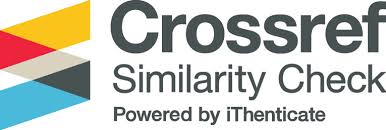Analysis Of Drug Management And Hanlon Strategy Method Improvement In Installation Pharmaceutical RSU Budi Setia Minahasa District North Sulawesi Province
Abstract
Pharmaceutical installation is a part in the hospital responsible carry out the management of a drug that covers the, selection , procurement distribution and use of medicine.The problem of managing a drug can affect the availability of medicines. This study aims to analyse the efficiency of drug management in IFRSU Budi Setia Minahasa regency.
The study design was descriptive for the data that is retrospective and concurrent. Data obtained from IFRSU Budi Setia stage drug management in, analyzed the efficiency of using indicators, then compared to the standard or the results of other studies.
The results show the results not according to standards: Selection, compliance with Fornas (65,28%), procurement, allocation of available funds (14,74%), the frequency of each item procurement of drugs (6,02 times a year), and EOQ (8,16 times/year), the distribution, the medicinal value of the damaged/expired (1,16%), the stock is dead (0,6%), the use, the number of items per strip of prescription drugs (3,22 sheet). The results according to the standard are: procurement, capital funds available to the overall funds needed (100%), incomplete SP/Invoices (0 times), the number of drug items held as planned (100%), the distribution, the accuracy of the amount of drug on card stock (100%), TOR (12,28 times), the rate of drug availability (12 months), stage of use, the number of items cents ( 3,22 ) prescription drugs, prescribing generic name (90,25%), the average time spent on prescriptions of non concoction (2,8 min) compounded prescription (3,5 minutes). Priority problem handling method hanlon: (1) percentage of stock dead, (2) percentage of and medicinal value expired and or damaged, (3) the number of items cents a prescription drug, (4) conformity items a drug that is available with fornas, (5) the frequency of procurement every items drug per year, (6) allocation percentage funds procurement drug 2019.
References
[2]. Fakhriadi A, Marchaban, Pudjaningsih D. 2011. Analisis Pengelolaan Obat di Instalasi Farmasi Rumah Sakit PKU Muhammadiyah Temanggung Tahun 2006, 2007 dan 2008. Jurnal Manajemen Dan Pelayanan Farmasi. 1(2). 94-102
[3]. Permenkes. 2016c. Peraturan Meteri Kesehatan Republik Indonesia Nomor 72 Tahun 2016 tentang Standar Pelayanan Kefarmasian di Rumah Sakit, Jakarta.
[4]. Sutato et al. 2017, Tentang Standar Nasional Akreditasi Rumah Sakit Edisi 1, Komisi Akreditasi Rumah Sakit. Jakarta
[5]. Hartati, S. 2019 Analisis Pengelolaan Obat Di Instalasi Farmasi Rumah Sakit Jiwa Daerah Surakarta Tahun 2019. Tesis, Surakarta: Program Studi Magister Farmasi, Universitas Setia Budi.
[6]. Permenkes. 2014b. Peraturan Menteri Kesehatan Republik Indonesia Nomor 58 Tahun 2014 Tentang Standar Pelayanan Kefarmasian di Rumah Sakit. Departemen Kesehatan Republik Indonesia. Jakarta.
[7]. Mallisa, M. 2018. Analisis Pengelolaan Obat di Instalasi Farmasi Rumah Sakit Umum Daerah Undata Palu Provinsi Sulawesi Tengah Tahun 2017. Tesis, Surakarta: Program Studi Magister Farmasi, Universitas Setia Budi.
[8]. [Kepmenkes], 2008c. Keputusan Menteri Kesehatan RI Nomor129/Menkes/Sk/II/2008 Tentang Standar Pelayanan Minimal Rumah Sakit. Departemen Kesehatan Republik Indonesia, Jakarta
[9]. Pudjaningsih, D. 1996. Pengembangan Indikator Efisiensi Pengelolaan Obat di Farmasi Rumah Sakit, Tesis, Magister Manajemen Rumah Sakit, Program Pendidikan Pasca sarjana, Fakultas Kedokteran, Universitas Gajah Mada, Yogyakarta
[10]. Suciati, Susi dan Adisasmito, Wiku BB. 2006. Analisis Perencanaan Obat Berdasarkan ABC Indeks Kritis di Instalasi Farmasi. Jurnal Manajemen Pelayanan Kesehatan. Vol. 9. No. 1, Maret 2006: 19-26.
[11]. Permenkes. 2014b. Peraturan Menteri Kesehatan Republik Indonesia Nomor 58 Tahun 2014 Tentang Standar Pelayanan Kefarmasian di Rumah Sakit. Departemen Kesehatan Republik Indonesia. Jakarta.
[12]. [Kepmenkes], 2010d. Keputusan Menteri Kesehatan Republik Indonesia Nomor 1455/MENKES/SK/2010 tentang Formularium Program Jaminan Kesehatan Masyarakat, Departemen Kesehatan Republik Indonesia, Jakarta.
[13]. World Health Organization. (1993). How to Investigate Drug Use in Health Facilities. Geneva: World Health Organization.
[14]. [Depkes RI], 2009c. Undang-Undang no.44 tentang Rumah Sakit, Direktorat Jedral Pelayanan Kefarmasian dan Alat Kesehatan Departemen Kesehatan Republik Indonesia, Jakarta
[15]. [Depkes RI], 2014d. PedomanPenerapan Formularium Nasional, Direktur Jenderal Bina Kefarmasian dan Alat Kesehatan, Jakarta.
[16]. [Depkes RI], 2008. Kamus Besar Bahasa Indonesia. Jakarta: Balai Pustaka.
[17]. [Depkes RI], 2005b. Undang-Undang Republik Indonesia Nomor : 23 tahun 2005 Tentang Kesehatan; Jakarta; Hal 1. Fisioterapi Indonesia; Jakarta; Hal.5
[18]. Quick, J.P, Rankin, J.R, Laing, R.O, O’Cornor, R.W. 2012, Managing Drug Supply, The Selection, Procurement, Distribution And Use Of Pharmaceutical, third edition, Kumarin Press, Conecticus, USA.













